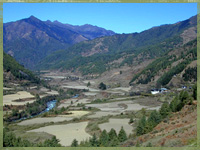 There
is a certain underlying purity associated with Bhutanese landscapes.
Physical panoramas tend to highlight an essential simplicity
over the immense diversity contained within. The ascetic whites
of high peaks stand out against the blanket of lush greenery.
High clouds and shrouding mists float suspended in the mass
of fresh clean air flowing lucent with the breeze. The overall
natural setting is preserved to a degree that is both unusual
and extremely valuable. Large expanses remain wholly undisturbed.
Cataloguing respective species only hints at the fact that entire
ecological systems remain relatively uncompromised. Such ecosystems
harbor a mass of biodiversity that is almost boundless, interacting
through extremely complex context specific processes. To appreciate
wildlife within its understated natural habitats is often to
be aware of its presence without ever making actual contact. There
is a certain underlying purity associated with Bhutanese landscapes.
Physical panoramas tend to highlight an essential simplicity
over the immense diversity contained within. The ascetic whites
of high peaks stand out against the blanket of lush greenery.
High clouds and shrouding mists float suspended in the mass
of fresh clean air flowing lucent with the breeze. The overall
natural setting is preserved to a degree that is both unusual
and extremely valuable. Large expanses remain wholly undisturbed.
Cataloguing respective species only hints at the fact that entire
ecological systems remain relatively uncompromised. Such ecosystems
harbor a mass of biodiversity that is almost boundless, interacting
through extremely complex context specific processes. To appreciate
wildlife within its understated natural habitats is often to
be aware of its presence without ever making actual contact.
Bhutan's environment is often referred to as 'pristine'.
Such labeling, alluding to some immaculate perfection, serves
to emphasize the dominance of the natural over the man-made.
It may also be misleading in that it neglects a fundamental
human dimension that always causes certain disruptions. Human
interventions have an inclination to simplify ecology, often
affecting its essential multiplicity. In Bhutan only a very
minor proportion of land area is currently used for productive
pursuits, and the fundamental relationships between the environment
and its human inhabitants are currently unassuming and essentially
sustainable. There are basically four explanations for this:
the area suitable for agricultural production is very limited;
industrial resource use is heavily regulated; currently there
is not heavy population pressure on fragile marginal lands;
and conservation oriented policies limit encroachment.
Bhutan has to date been relatively successful in meeting
the imperatives of conservation and sustainable natural resource
management. However, although the natural resource base remains
largely intact, this cannot be taken for granted. Future pressures
on the natural environment will be fueled by a complex array
of forces, deriving from both traditional and modern sectors.
As a product of both development and underdevelopment, these
include population growth, unemployment, agricultural modernization,
hydropower and mineral development, industrialization, urbanization,
tourism, competition for available land, road construction
and the provision of other physical infrastructure associated
with social and economic development. The full monetization
of the economy is also impacting on traditional land management
systems, based on the principles of participation and cooperation.
Localized unsustainable resource pressures are already emerging.
In certain vicinities extraction rates for fuel-wood, timber
and other forest products are already approaching unsustainable
levels. In areas close to population centers an estimated
10% of forest area is degraded as a result of heavy natural
resource utilization. The progressive removal of vegetation
cover, especially in critical watershed areas, is beginning
to affect the hydrological balance, leading to the localized
drying up of perennial streams and flash flooding. The determination
of the inevitable trade-offs required will be of fundamental
importance to the achievement of an acceptable degree of sustainability
in the future. The pressures will certainly increase, and
these increases will occur in some of the most fragile ecosystems
to be found anywhere in the world.
|



